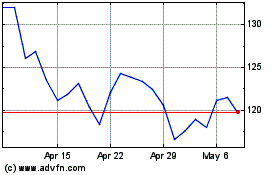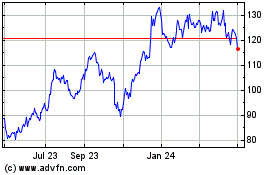StuyTown Owners, Tenants Clash Over Rent Law -- WSJ
March 13 2020 - 3:02AM
Dow Jones News
By Will Parker
This article is being republished as part of our daily
reproduction of WSJ.com articles that also appeared in the U.S.
print edition of The Wall Street Journal (March 13, 2020).
New York state's new rent regulation law is reopening a rift
between some tenants at New York City's largest rental complex and
its majority owner, the giant real estate investor Blackstone Group
Inc.
At issue is whether the new law should apply to thousands of the
highest-paying renters at Stuyvesant Town and Peter Cooper Village,
which has more than 11,000 apartments overall on Manhattan's East
Side.
The tenants association said that the new rent law means their
annual increases should remain much lower than what Blackstone
would otherwise charge them, according to a lawsuit filed in a
Manhattan state Supreme Court last week.
Blackstone said the tenants bringing the suit represent the
wealthiest tenants at the complex who already acknowledged their
units would be deregulated in a previous court settlement.
After Blackstone and a partner bought the complex in 2015, the
new owners reached a deal with the city to keep rents limited at
5,000 of the apartments for the next 20 years and set some
guidelines for how the other apartments would be treated, in
addition to adhering to other rules from a previous court
settlement.
"The litigation filed on behalf of the complex's highest-income
tenants seeks to invalidate a court-ordered agreement, and
indefinitely extend rent control for residents paying over $4,000 a
month," said Jennifer Friedman, a Blackstone spokesperson.
Blackstone estimates the tenants affected by the lawsuit have
incomes of $262,000 a year on average. Under the previous rent
laws, tenants making more than $200,000 a year for two consecutive
years could have their apartments deregulated, but that measure was
removed by the state Legislature last year.
The Stuyvesant Town litigation could potentially affect some
6,000 apartments at Stuyvesant Town not covered by Blackstone's
affordability deal with the city, as well as thousands of other
apartments citywide that are rent-stabilized under a city property
tax credit called J-51.
More than half of Stuyvesant Town is covered by this tax credit.
It requires rent stabilization of these apartments until June, when
tax benefit expires, according to a landmark 2012 court settlement
with the tenants. But the tenants suing Blackstone say the new rent
laws passed last year no longer allow these units to be
deregulated, even once the J-51 credit expires.
Ms. Friedman said Blackstone wouldn't increase rents more than
what is allowed by the city's rent stabilization law until the
court decided the case, and that its affordability agreement for
other apartments would stay effective. "Our commitment to preserve
5,000 units of affordable housing stands," she said.
The new lawsuit at Stuyvesant Town is the latest sign that New
York's new rent laws are changing the balance of power between
landlords and tenants. The real estate industry, once known for its
strong lobbying and political clout in New York's state and city
government, has more to lose this year, as the New York state
Senate's Judiciary Committee considers a bill that would bring rent
control to nearly every apartment unit in the entire state.
Tim Collins, the attorney representing the tenants, said rent
stabilization laws exist to protect all tenants, not just
low-income ones, from price gouging, as well as to prevent
landlords from taking advantage of New York's housing shortage.
"The owners are upset about having their investment-backed
expectations disrupted," said Mr. Collins. "The law does not
perfectly protect investment-backed expectations."
Former City Councilman Dan Garodnick, the current president of
the Riverside Park Conservancy and a lifelong Stuyvesant Town
resident, helped negotiate Blackstone's deal with the city in 2015.
He said that the fight over the maximum-allowed annual rent
increase can mean the difference between a family that can keep
their home and family that has to leave.
"This is the middle class of New York. They are not the poorest
and they are not the richest, and that does not mean that they do
not struggle," he said.
Write to Will Parker at will.parker@wsj.com
(END) Dow Jones Newswires
March 13, 2020 02:47 ET (06:47 GMT)
Copyright (c) 2020 Dow Jones & Company, Inc.
Blackstone (NYSE:BX)
Historical Stock Chart
From Mar 2024 to Apr 2024

Blackstone (NYSE:BX)
Historical Stock Chart
From Apr 2023 to Apr 2024
